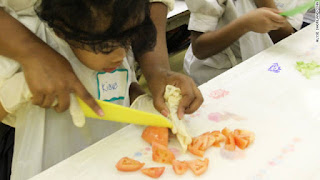New York (CNN) -- Students gathered as the chef sliced tomatoes with a plastic knife in a Brooklyn public school cafeteria. Their eyes followed as she held up a slender green cylinder before the crowd of parents and kids in plastic aprons and hairnets.
"What's that?" kids shouted.
"It's a scallion. But don't eat it now," warned Leigh Armstrong, a culinary student and volunteer chef. "It doesn't taste like celery."
Armstrong was helping at Cooking Matters, a free, six-week class that teaches parents and kids how to shop for and prepare healthy, inexpensive meals. The program launched 20 years ago through the nonprofit Share our Strength, and it now serves more than 11,000 families across the country.
Most participants use or have used food stamps, free or reduced-price school lunches or food pantries to cover their nutritional needs, and almost all are still looking for ways to stretch a few ingredients into meals.
The number of families that struggle to get enough food has increased in recent years.
The U.S. Department of Agriculture reported that in 2010, 14.5% of households in the United States -- about 17.2 million -- lacked the resources to provide enough food for everybody. Among those, about 6.4 million households saw normal eating patterns disrupted or reduced because there wasn't enough food.
Food insecurity -- uncertainty about where the next meal will come from -- is particularly hard on one group: children.
Read more




















No comments:
Post a Comment
Subscribe to our publication. Do not miss out on any information.
Join us on Facebook:
https://facebook.com/ireporterinternational
Follow us on Twitter:
https://twitter.com/ireporterng
Note: Only a member of this blog may post a comment.